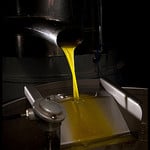 Olive oil comes in a variety of colors, from light pale yellow to dark green.
Olive oil comes in a variety of colors, from light pale yellow to dark green.
So what makes olive oil come in so many different colors? There's a number of reasons, ranging from what it's made from, to how it's made, to how it's stored. Let's review the 5 most common things that can affect the color of an oil to make it what it is.
1. The Grade of Olive Oil That It Is
The grade of olive oil can have an impact on the color. For example, a high quality Extra Virgin Olive Oil is going to be a different color than Refined (or Light) Olive Oil. Why? Refined Olive Oil is processed using high heat, which removes much of the color and flavor from the oil. Any processed oils (including Pure Olive Oil, Refined Olive Oil and Olive Pomace Oil) are going to be lighter in color.
2. The Olive Varietals That Were Used
The type of olive has a big impact on the final color of the oil. Some types of olives produce lighter colored oils, and some produce darker oils. It often is impacted by the pigment in the skin and flesh which becomes a part of the "olive paste" which is pressed.
3. When In The Season The Olives Were Harvested
Many varieties of olives are green as they're growing and turn into a deep purple slowly as they become ripe. Some just become a deeper color of green. When the olives are harvested, some olives are riper than others. In fact, there's often a mix of green and purple as each batch is headed to the mill. Imagine you're looking down into that load of olives... you can picture that if most of them were green, you might expect a different colored oil than if the majority of the olives were deep purple-- almost black.
4. The Climate In The Growing Region
Surprisingly, the country that the olives are grown in have no impact on the color. What does have an impact is the region that they're grown in. Olives care about things like soil, temperature, average humidity and rainfall-- not country border lines. They're affected by the natural climate, and the trees (including its fruit-- the olives themselves) are characteristed by many of these slight differences in growing climates. For example, southern Italy is going to have a slightly different climate than northern Spain. That's the difference you may be seeing.
5. How Old The Oil Is/What Condition It's Been Stored In
If the oil is two years old and it's been kept in sunny, warm conditions, you can be guaranteed that the oil will be a different color than when it was first pressed out of the fruit. Oil color changes over a length of time as it ages. That process is supercharged if it is stored in poor conditions where air, heat and sun can damage it. Just take a look at these pictures to see the comparison of the same oil stored in good conditions vs. bad.
Remember, don't be put off by different colors of olive oil. Neither bright yellow nor dark green are an indication of quality-- it's just the characteristic of that particular oil. Just like people come in all different colors (as do horses, cats and dogs, flowers-- shall I go on?), so does olive oil. That's just what makes it unique!
Topics: Quality Control












